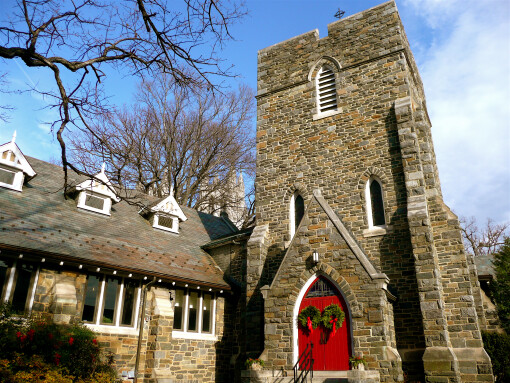The Thirteenth Sunday after Pentecost
Series: Pentecost
Speaker: The Rev. Matthew Hanisian
Tags: christian, episcopal, faith
So Jesus asked the twelve, "Do you also wish to go away?" Simon Peter answered him, "Lord, to whom can we go?
There is a quiet inside joke amongst preachers of which Jesus surely was the captain: You know you’re doing something right when someone gets up and walks out of church while you’re preaching. Offending folks now and again is a sure sign, as the preacher, you are being Jesus-like.
And with the start of this passage from John’s gospel where Jesus says and commands us to do two offensive things. “…eat my flesh and drink my blood.” not only does it seem plausible and even likely that his disciples might wish to go away, but any sane-thinking three year-old would surely reply, “Ewww, Jesus! Gross!”
And, Jesus--to be as graphic as possible about this, to increase the “Eww-factor”—uses the Greek verb: “trOh-gOhn” that our translation of the bible, blandly translates as “eat.” The more accurate translation is “gnaw.” Let this image sink in for a moment: Jesus is commanding us to “Gnaw on my flesh, drink my blood.”
Gnaw certainly is less dainty, less civilized. Knife and fork? Nope. Napkins? Yes please. When we gnaw on a bone, doesn’t it get all over our faces, aren’t we trying to get every bit of meat…every bit of goodness we possibly can get?
And not to be outdone, the “drink my blood” portion of this commandment is equally offensive—ESPECIALLY so for the Jews to whom Jesus was speaking in our passage.
The Hebrew Scriptures are very clear in Leviticus and Deuteronomy on the subject of ingesting blood, “You shall not eat the blood of any creature, for the life of every creature is its blood” (Lev. 17:14; cf. Deut. 12:23). And at the risk of putting too fine a point on this one, Jesus isn’t talking about just ANY creature; he is talking about his HUMAN blood.
Now, we get the tail end of his tirade about “eating my flesh and drinking my blood.” BUT, if you back up another four verses Jesus says mentions this offensive act to the officials in the temple four ADDITIONAL times. So, it seems that Jesus is on an offending streak here, working in concentric circles with his “eat my flesh, drink my blood” campaign. He’s started off offending those least close to him--the officials in the temple. Then he goes to work on the large crowd of disciples who now are following him…he offends them and most of THEM leave. Then finally he is left with his inner circle of disciples…who for the very first time in John’s gospel get a name, an identity separate from the rest of those following Jesus: he offends “the twelve.”
So this morning we too, along with the remaining twelve disciples, are stuck with a Jesus who is perhaps too hard to swallow.
All of this talking about gnawing on Jesus and drinking his blood, and Jesus as the true bread of life, gets us thinking about the institution of Holy Communion and the sacraments; which of course then takes us off into the weeds of thinking about whether we believe in transubstantiation or consubstantiation…which is all fine and well. But I think that takes us a bit off track so we will leave all of that for another sermon for another time.
Instead, this morning I would like us to think about the question-and-answer session that Jesus and Peter have with one another at the end of our passage. That’s where I think, and again, please excuse the pun, that’s where the meat of the story is for us.
Watching the crowd of disciples turn their back on Jesus and leave, Jesus goes to those who had been with him the longest, whom he sought out and found, and called by name to be his disciples. And, in what could easily be imagined as a poignant moment he looks at “the twelve” and he asks them: "Do you also wish to go away?"
Do you also wish to go away? It is the ultimate question for any disciple, for the twelve then, and for us today. In this question is the question God could seemingly be asking all of us who are here in church this morning instead of being out there with the other estimated 60% of the U.S. population that doesn’t go to church.
When the teachings of Jesus which are hard, not easy or just plain gross…when the going gets really tough—even to the point of being unacceptable, or so challenging as to be seemingly impossible… Do you ALSO wish to go away? Let’s think about this perhaps even more practically: when our lives seem to fall apart, when we experience loss, when what was once solid ground is now shifting sand…Do we also wish to go away? And, I wonder if deep down when we feel we have hit absolute bottom, we also want to say, “That’s it, God, I’ve had enough!” We can even go so far as saying, “God, you clearly don’t exist. Even if you DO exist, you certainly don’t care about me, because if you DID you wouldn’t have LET THIS happen to ME! I can no longer believe in you.” I know that I’ve been there, and perhaps you’ve been there too.
In those moments of outrage, anger, frustration, humiliation, fear, and all the rest, turning back, turning away from Jesus would be an easy thing to do. And, perhaps, for a time we have turned back, turned away with our shattered faith, our shattered life and simply left—simply stopped coming to church, or simply given up believing in a God that loves us so much, as John reports back in chapter 3, verse 16: “For God so loved the world that he gave his only Son, so that everyone who believes in him may not perish but may have eternal life.”
Let’s face it, the world and our lives will give us a thousand reasons for not believing. We have a thousand reasons for not making the effort to engage or even struggle with our faith. With commands like we have this morning to gnaw on Jesus’ flesh and drink his blood…well, now we might have two more reasons.
We have plenty of reasons for moving not TOWARDS God, but instead moving in any of a hundred different directions—NONE OF WHICH brings us any CLOSER to God. All of those other directions we move will yield at BEST temporary escape from our issues, and at WORST lead us further into our own darkness and brokenness. The choices we make, the hand we’re dealt, the life we live can seemingly FORCE US to turn away from God, to no longer follow Jesus.
But, if we go back to our gospel passage from this morning—and here, by the way is the Good News—for all of his moments of “not getting it” and all of his moments of being impulsive, arrogant, and down right wrong about things related to God…or belief…or following Jesus, because let’s face it, Peter doesn’t get it right MOST of the time (remind us of anyone we know?)
For all of that, Simon Peter is the one who answers Jesus question. Jesus asks, “Do you also wish to go away?" And Peter answers with all of the simplicity that the truth usually boils down to. Peter answers, "Lord, to whom can we go?...... You have the words of eternal life.”
Peter’s words are the question and summation statement of our faith, of our salvation.
Simon Peter had, as we do today, a number of alternatives of “to whom can we go?” In his day Peter had the Essenes, the Pharisees, the Saducess, the Zealots, the temple authorities to name the Jewish religious alternatives. In our time, the answer to that question of, “to whom can we go?”—if you read the statistics or headlines—isn’t to a different denomination or even a different religion. Most often, the answer is that people simply abandon their faith and religion…they become, “spiritual, but not religious.” Or even worse, they simply just leave.
But Peter speaks as one who has had those other options eliminated by a powerful encounter with Jesus, with the divine. He speaks as one who has been changed by walking with Jesus. By and through his relationship with Jesus he KNOWS to whom he can go. And he knows WHY. Because Jesus is the living bread of eternal salvation.
When in those moments of our lives when everything is falling apart around us we can remember Peter’s question to Jesus, “Lord, to whom can we go?” And why can we go to Jesus? Because we can choose the God who has already chosen us.
And even better, and how the church is, I believe, at its best is when we—the body of Christ, we, the church—go and are present with those who are suffering, those who are hurting or anxious or grieving or even falling apart. You don’t have to look far to find those folks for whom that is happening. They might be as close as the person next to you in the pew.
In those moments when we are present with our brothers and sisters in Christ we become the living Word; in those moments we become the body and blood of Christ that gives life and healing to this broken world.
Anyone who has done pastoral care, or even PROVIDED CARE to someone, or especially anyone who has RECEIVED any kind of care KNOWS that sometimes—in fact MOST of the time—just being present with the person who is in crisis or in need is enough.
In THOSE moments we, as Christians, the followers of Jesus, can BE the living Word; we can BE the bread of life for our broken neighbors, our broken brothers and sisters in Christ, indeed our broken world.
When we come and partake of Holy Communion we have inside of us the body and blood of Jesus—Jesus is abiding in us. When we engage with our faith—especially when we wrestle with our faith—gnawing on both the difficult and joyous moments of our faith life—we invite Jesus to abide more fully in us. In short, we HAVE the words of eternal life—and with the abiding presence of Jesus inside of US, can BE the bread of life.
Lord, to whom can we go? Lord, to whom can we go when we are broken and hurting? Lord, to whom can we go when we “have followed too much the devices and desires of our own hearts?” Lord, to whom can we go when we have done those things which we ought not to have done? Lord to whom can we go when our brother or sister is suffering? Lord to whom can we go?
To the one who is eternal life. To the one who is the bread of life. To God.
Thanks be to God.
AMEN.
 Welcome to St. Alban’s Church! Every Sunday, and most days in between, people gather in this place to worship, to learn, to grow, to share the joys and struggles of our lives, and to seek God’s grace in the midst of our lives. We do not come because we have it all figured out, but because we are seeking light on the way. We come as we are and welcome one another.
Welcome to St. Alban’s Church! Every Sunday, and most days in between, people gather in this place to worship, to learn, to grow, to share the joys and struggles of our lives, and to seek God’s grace in the midst of our lives. We do not come because we have it all figured out, but because we are seeking light on the way. We come as we are and welcome one another.

